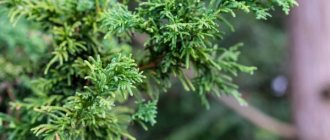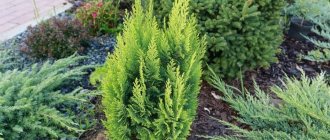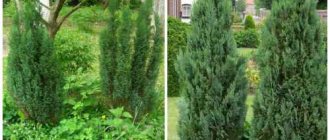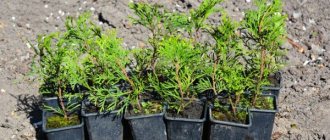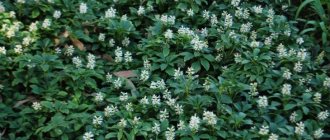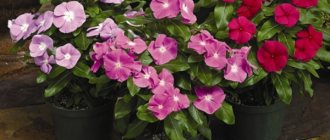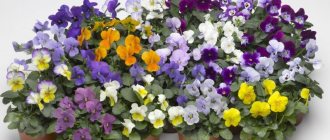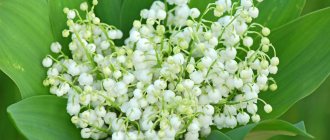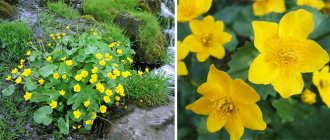» Shrubs and trees » Lawson's cypress Columnaris - an evergreen long-liver
0
2720
Article rating
The slender, single-stemmed Lawson cypress Columnaris, densely covered with shoots and dark green needles, is widespread in the landscape of private and industrial gardens. The plant, originally from America, has fast growth, endurance and high decorative value throughout the year.
- How to care
- Watering
- Loosening and mulching
- Feeding
- Trimming
- Preparing for winter
- Reproduction
- Seminal
- Cuttings
- Diseases and pests
- Application in landscape
- Reviews
Lawson's cypress Columnaris - an evergreen long-liver
Brief information about the variety
- Needle color : from brownish to pure green.
- Plant height : does not exceed 5-10 m.
- Crown width : about 200 cm.
- In what regions does it grow : hastily cultivated in the south of Russia, in the Volga region and the Central zone.
- Planting Features : Prefers sunny places or light shade.
- Immunity : no resistance to scale insects, spider mites and fungi.
- Life expectancy : at least 10 years.
Description of the variety
Lawson's cypress has been found wild in North American and North Asian forests at high altitudes. In the middle of the 19th century, it was first brought to Europe, where it was successfully propagated and began to be used for landscaping. The crown shape of these trees or shrubs is conical, the average height is 80 m. The plants are durable and can grow up to 100 years or more. Male and female flowers are formed on the same tree.
The tips of the shoots of Lawson's cypress have a characteristic growth direction that is horizontal or slightly drooping in different directions. This decorative appearance differs from thuja. The shoots are more flattened than those of cypress. They differ from junipers in the type of needles: they are flat-scaled, while junipers have subulate-pointed triangular needle-shaped leaves. Cypress varieties have a waxy coating of various shades: from silver to blue.
In May, cypress trees begin to bloom. In botanical parlance, this process is called “dusting.” Sensitive people are more likely to develop allergies in the form of hay fever during this period. Male flowers are small, scattered along the entire length of the shoot, brightly colored with red, orange or yellow scales. Female flowers are greenish, located at the ends of the shoots.
The following varieties and hybrids of the Lawson cypress species are highly decorative:
- Columnaris - columnar cypress. When planted in a row, Columnaris trees are characterized by a strong degree of uniformity in height and growth habit, making it one of the best varieties for creating hedges. The branching of the central stem comes from the soil. The average height of trees 10 years after planting is from 3 to 4 m, the maximum is 10 m. The diameter of the crown is 2 m. The color of the needles is dark green with a bluish tint. Winter-hardy, undemanding to light;
Lawson cypress varieties are valuable, the cost of seedlings is considerable, and therefore proper planting and care become of particular importance.
Growing regions
The Southern Federal District is considered the most suitable for growing Lawson Columnaris cypress.
This is due to the fact that wild cypresses, like cultivated varieties, need moisture and plenty of light and high temperatures.
Some gardeners managed to grow this variety in Central Russia and the Volga region (for example, there are known cases of its growth in dachas in the Moscow region). But in such conditions the plant will require special care and attention.
Difficulties and problems of growing
Very often there are situations when the Lawson Elwoodi cypress dries out or has dried out. What to do? The plant can still be saved, although it is extremely problematic. This usually happens when grown at home.
The main reasons are dry indoor air and too high temperatures. Unfortunately, not everyone and not everyone succeeds in growing a beautiful and healthy cypress indoors. Therefore, in such situations it is necessary to increase air humidity and provide the plant with regular spraying and watering. At home, the plant overwinters well at fairly low (about 10-15 degrees) temperatures. The cypress tree cannot stand the heat.
If the Lawson cypress turned yellow after winter, then the crop probably received a spring burn; this happens very often.
Biostimulants, for example, Epin, will also help.
The root system is also likely to rot, so you may have to remove the plant from the ground and inspect the root system for rot.
general characteristics
Columnaris is an evergreen plant with a straight trunk 5-10 m high. It has a narrow column-like shape, upward-directed tight and thin shoots, which are formed by small branches 10 cm long.
The crown diameter of an adult cypress tree reaches 2 m, and the average increase in width reaches 10 cm. The color of the needles varies from green to brownish (but in the Columnaris Glauka variety it is blue).
The root system is strong and branched, which allows it to cling tightly to any soil.
Types and varieties, photos
All types of plants have characteristic features:
- cone-shaped or spreading crown;
- branched shoots covered with needles (in young plants) or triangular scales;
- scale color - various variations of green, from light green to bluish or with a hint of yellow;
- spherical cones with a tuberous surface with a diameter of up to 1.5 cm;
- plants are monoecious - one individual contains both female and male generative organs.
Depending on the type and variety of trees, they may differ in size, shade of needles, and crown shape, but they are all valued for their characteristic aroma, which is caused by the essential oils released. Cypress oil has several beneficial properties, the main one of which is the inhibition of pathogenic microflora. Thanks to this, the air in the room or in the area adjacent to the plant becomes extremely healing.
Cypress pea
Under natural conditions in its homeland (Japan), a tree can grow up to 20-40 m in height, and tall varieties reach 70 m. For decorative purposes, low-growing varieties are used, which in harsh climates are not subject to freezing, and, if necessary, are easily covered. Among the most famous varieties of pea-bearing cypress are the following:
- Boulevard - height 1.5-2 m, crown width 1 m. The shade of the needles is bluish-silver, characterized by winter hardiness and unpretentiousness to lighting;
- Plumaza - height 8-10 m, crown width up to 3-5 m. Changes the color of the needles depending on the season (brown or golden yellow in winter), undemanding to clean air and sunlight;
- Filifera Nana is a dwarf plant with dark green needles, in adult form reaching a height and width of no more than 1 m. It is resistant to frost, pest attacks, and air pollution.
Thuja cypress
The tree has a cone-shaped crown and in nature reaches 25 m in height. It grows well on moist, loose (sandy or peaty) soils, but poorly on dry and clayey soils. The densely located needles have a light green or dark bluish color. The most common varieties are:
- Andalyensis is a dwarf plant up to 2.5 m high with short dense branches and bluish-green needles with a pronounced aroma;
- Aurea – tree grows up to 25 m, changes color depending on the season (golden yellow in summer, bronze-brown in winter), winter-hardy;
- Konica is a slow-growing dwarf keeled form (annual growth 2-3 cm). The color of the needles is bluish-green in summer, with a brownish tint in winter.
Lawson's cypress
The plant has a cone-shaped shape with a wide range of shades of needles depending on the variety:
- Elwoodi - the tree grows up to 3 m in height, has spreading branches slightly drooping at the ends with green-blue needles;
- Yvonne - the height of the plant can reach 2.5 m, the branches are located almost vertically in a conical crown, the color of the needles is from light green to golden yellow;
- Columnaris - grows to a height of 5-10 m, branches cover the trunk almost to the ground, the needles have a gray-blue color.
Lavsana cypress is one of the most favorite species for decorating the personal plots of Russian amateur and professional gardeners.
Types of cypress trees for indoor growing
The home cypress has a height of no more than 20-40 cm, in all other respects it is a miniature copy of the well-known varietal varieties: pea-shaped, thuja-shaped, Lawson. Known species for indoor cultivation are also the following:
- Blunt;
- Mourning;
- Nutkansky;
- Formosan.
The photos with names below will give you an idea of the appearance of the plants.
Variety Elwoodi
Variety Goldcrest Wilma
Variety Bolivar
Landing
Miniature cypress is sensitive to growing conditions. And not all specimens take root in harsh climates.
To grow a full-fledged shrub, you need to choose the right seedling and prepare a place for it.
Selection of seedlings
Anyone can purchase Columnaris at a specialized gardening store or nursery.
You should not trust private traders: their goods are not certified and not processed in accordance with the standards.
Some gardeners advise buying plants bred in your region because they are already adapted to weather and climate conditions. It is better to choose shrubs in 3 or 5 liter containers (i.e. small ones), because the grown flora takes root less well in a new place.
Preparing the site
Choose a sunny place for planting
Cypress Columnaris prefers to grow in an area with plenty of sunlight or in light shade (For example, on a small hill). This arrangement also allows you to get rid of moisture accumulation at the roots.
There are no requirements for the chemical composition of the soil; it is only desirable that it be loose, fresh and well-drained.
Preparing the soil for planting consists of loosening it and adding organic humus.
Landing technology
- Preparations begin in the fall. At the selected location, make a hole 60 cm wide and 80 cm deep.
- It is watered with dechlorinated water, drainage is placed at the bottom (broken brick, gravel and small stones are suitable)
- The hole is partially filled with nutrient soil (the composition includes turf soil, leaf litter, sand and peat)
- Already in the spring, the recess and roots of the seedlings are watered abundantly.
- Plants are placed in the center and covered with soil. The root collar should be flush with the surface.
- The tree trunk space is mulched using bark and large wood chips.
Planting and caring for the plant
Seedlings must be purchased from trusted suppliers, greenhouses or nurseries. Planting of the purchased tree is carried out in the spring, in well-warmed soil. It can be planted either in single groups or by the alley method.
The planting hole is dug deep and wide. A layer of drainage, compost or humus is placed at the bottom. Before planting a seedling, it is necessary to pour a hole to allow drainage to settle. Then the tree is placed and carefully covered with soil, making sure that no air cushion is formed. The planted seedling must be watered again and the voids filled with dry soil.
Lawson's cypress is a whimsical plant. To get a beautiful, healthy plant, you must follow the following rules of care:
- feeding;
- watering;
- pruning;
- disease prevention.
Watering, fertilizing and pruning
Watering is necessary regular and moderate. Overwatering, as well as underwatering, can have a detrimental effect on the plant.
The plant is moisture-loving, so it needs constantly moist air. To do this, after watering, the soil is mulched with straw or sawdust. Mulch will not only retain moisture, but also provide the tree with additional nutrients.
Cypress trees must be fertilized every spring with complex mineral fertilizers. Before applying fertilizer, the soil is watered so that the root system does not get burned.
Pruning is done in the spring to prevent diseases. To do this, old, poorly overwintered branches are removed, and very spreading ones are pruned to give a decorative appearance.
https://youtube.com/watch?v=rVPGwSa9jnI
Preparing for winter
If cypress is grown in central Russia, it must be prepared for wintering. Although the variety can grow at sub-zero temperatures, it is not worth experimenting with. The tree is covered with spruce branches for the winter. If the winter is snowy, then snow will be a good additional shelter option. In addition, the cypress tree needs to be protected from gusty cold winds.
Cypress is grown in single and group plantings, in flower beds and near a pond. The plant is also ideal for creating hedges and borders. Many gardeners decorate rock gardens, rock gardens and Japanese gardens with trees.
Care
Caring for the Lawson Columnaris cypress is quite simple, although the plant is alien to the climatic conditions of Russia. But without following the rules of watering, fertilizing and mulching, it is not possible to grow a good tree.
Watering
The description of the places of original growth proves that the shrub is sensitive to watering.
It is necessary to moisten the soil around it at least once every seven days. Water consumption per adult plant is approximately 10 liters, for young shoots during the active growing season it should be up to 12-15 liters, but for old trees 5 liters is enough. Saplings and young cypress trees respond well to spraying. Therefore, once a week it is worth moisturizing the green part.
Feeding
It is customary to apply fertilizing in the spring and early June. If you deviate from this fertilization regime, the plant simply will not have time to prepare for winter. Young animals are fed 60 days after planting.
And adult Lawson Columnaris cypress trees are fertilized every 14 days as they grow in height. Special fertilizers for evergreen flora (Novofet, Agricola and others) are considered the most productive. Package instructions should be followed, but young shrubs should receive half the dose of fertilizer for mature ones.
Mulching and loosening the soil
Loosening is mandatory for cypress trees; it should be carried out after any rain or artificial watering.
Cypress must be fertilized
Accuracy is required: the roots of young growth are located near the surface and are easily injured. At the same time, it is worth organizing weeding.
Cypress trees generally do not tolerate close proximity to other plants. The last stage is mulching. It is most convenient to use wood chips or tree bark as mulch.
Haircut and trimming
The formation of the cypress crown occurs in the spring; you can start trimming the plant in the second year of its life. The greenery can be given any desired shape, but it is worth considering that excessively long branches or those that grow in the wrong direction must be removed.
You need to trim branches and trim leaves using special tools that have been disinfected. These include tongs and garden shears.
Preparing for winter
Cypress can withstand low temperatures. But for the first three years it is worth covering the tree, because bright spring and winter sun rays can have a bad effect on the quality of the needles.
Each one is individually wrapped in bags made of craft paper or ordinary burlap. In cold regions, it is recommended to grow small cypress not in open soil, but in large tubs. Then for the winter you can easily protect the plant from frost by moving it indoors.
Features and morphological description of Columnaris cypress
Lawson's cypress Columnaris is a coniferous evergreen plant that belongs to the Cypress family and is considered the most popular among other crop varieties. All varieties of Lawson cypress, including the Columnaris variety, are loved by gardeners for their highly decorative appearance and relative cold resistance and ease of care, which is especially important in Russia.
According to generally known data, the homeland and place of growth of wild cypress species is considered to be the territory of North America and East Asia, however, in recent years, individual specimens can increasingly be found in Europe. The Columnaris cypress variety appeared around the 18th century. And since 1854, this evergreen coniferous plant has spread widely throughout the northern hemisphere.
Description of Columnaris cypress:
- Cypress Columnaris or Chamaecyparis lawsoniana Columnaris is a very beautiful, spectacular and ornamental plant from the entire variety of coniferous crops, which has received great recognition in the horticultural world and is often used for landscaping garden plots and city parks, just like the well-known thuja. This variety of cypress, due to its excellent characteristics of hardiness and unpretentiousness, is considered the best option for planting in Russia, with the exception of the northern regions, in comparison with other varieties of this crop.
- The Lawson's cypress plant Columnaris is a tree that in nature can grow up to 7-8 meters. But when growing a crop in the garden, the height of this tree will not be so significant. The cypress tree has a fairly fast growth rate; in a year it can grow by about 15-20 cm, which allows it to reach a height of 3-4 meters by the age of 10 years.
- The root system of a coniferous tree is represented by strong and abundantly branched roots, which for the most part are adventitious.
- In its appearance, Columnaris cypress is a very ornamental plant, which is achieved by a narrow columnar and regular crown shape, which becomes better and denser with age.
- The crown is formed by dense and short branches that are directed vertically upward and begin to branch near the ground. At the same time, the branches are located very densely, which allows the plant to maintain the shape of the crown.
- The skeletal shoots of cypress are short, only 10 cm. Covered with brownish-brown thin bark.
- Throughout the year, the decorative effect of this plant lies in the needles of a grayish-blue hue.
- The needles of the Columnaris cypress are evergreen, scaly, widely spaced and tightly pressed to the shoots. In winter, the tint of the leaves becomes more grayish than blue.
- The needles of this plant exude a pleasant aroma and are very soft and pleasant to the touch.
- Thanks to the large number of branches, the plant can grow up to 2 meters in diameter, which makes it possible to use the variety for hedges.
- Lawson's cypress Columnaris is one of the most frost-resistant varieties among all types of cypress, which is why it is often used in central Russia. The frost resistance zone of this variety is 5b, which corresponds to minus 25-29 degrees below zero. In more northern regions, for example in Siberia, it is quite difficult to grow Columnaris cypress; the plant can freeze and die.
Using Columnaris cypress in landscape design
Like all coniferous plants, Columnaris cypress is considered a very ornamental plant, which is actively used by gardeners and landscape designers for landscaping and decorating their gardens and personal plots. Today there are simply a huge number of options for using this plant in a variety of compositions that will favorably emphasize the originality of your land. Let's look at the main ways to use Lawson Columnaris cypress in garden design.
- Cypress of this variety looks very beautiful in solitaire plantings against the backdrop of a green lawn. Thanks to the beautiful and compact shape of the crown, such a tree does not need neighbors to decorate the area.
- In addition, Columnaris cypress seedlings can be safely planted in large garden containers and pots. Thus, you can easily and quickly move trees around the site, creating several garden compositions at the same time.
- These coniferous plants of this variety look impressive in group compositions. For example, you can plant three Columnaris cypress seedlings nearby.
- Also, many gardeners prefer to plant entire compositions from a wide variety of coniferous plants: cypress, thuja, spruce and pine.
- Ornamental shrubs and trees can also be planted with coniferous plants, which are located around tall Columnaris cypress trees.
- Gardeners especially often use this variety of cypress to create dense and even hedges to divide a plot or to create the boundaries of a personal plot.
- In recent years, Lawson's cypress Columnaris is often planted within the city in various park areas, as this plant is resistant to air pollution.
As you can see, cypress is a very popular plant that has long been loved by gardeners and is often used for landscaping areas. Below are photos of Lawson Columnaris cypress in various uses.
Reproduction
Lawson's cypress Columnaris can be propagated in one of two ways standard for the cypress family: cuttings or seeds. Action algorithms will differ markedly.
Seed propagation
Seed propagation involves the independent collection of fruits and the isolation of seed material from them. In order for young seedlings to grow successfully, it is important to carry out timely stratification and subsequent correct sowing.
The process begins in February: you need to soak the seeds in a stimulator for 480 minutes, after which they are immersed in moistened river sand.
The pot with seeds should be kept at a temperature no higher than 5° and at high humidity. After 30 days, the container is moved to heat.
Seed growth takes a long time. The first sprouts appear after 2.5-3 months. Next, you need to wait until the seedlings get stronger, and then you should move the plants into separate pots.
Cuttings
Cuttings are considered a simpler and more practical way of growing cypress.
In spring, cut branches 15 cm long. Remove the bark from the bottom and soak the branches in a growth stimulator for 8 hours. Treated cuttings are planted in mineral-rich soil to a depth of 5 cm.
The crown is covered with bags, which creates a greenhouse effect, and after that they take root quite quickly. After 45 days, new needles begin to form.
Diseases and pests
Inspect trees regularly for signs of disease.
Cypress has good immunity and is almost unaffected by pests.
The greatest risks for it are fungal diseases, scale insects and spider mites. An infected plant can be easily identified by its rapidly falling yellow needles.
Complex treatment with acaricidal agents will help, or you will have to say goodbye to the bush.
Also, due to improper watering, the roots may suffer. They can be saved by removing the affected parts and subsequent fertilization with fungicides.
Use in landscape design
- Lawson's cypress is easy to give the desired shape, which is why it is used to create hedges.
- The plant fits into alpine hills and rocky gardens, because this corresponds to its natural habitat. If planted in containers and tubs, it can decorate terraces and attics.
- The needles of the Glauka variety have a blue tint and successfully emphasize the cold tones of the buildings;
- The shrub is often planted next to pools: moisture improves the quality of green mass and activates growth;
- Primroses and perennials bloom well under the tree, so it is found in club compositions.
Lawson cypress ideas for site design
The attractiveness of lawson cypress as an element of flowerbed or garden compositions is undeniable. The plant captivates designers with its varietal diversity and decorativeness throughout the year.
Cypress is often used to create hedges. Tall or medium-growing varieties are suitable for this purpose. Group plantings of cypress can be used to zone a site.
A cypress hedge can be made of any height and length.
In landscape design, cypress is used in completely different stylistic compositions. Looks great on alpine slides and in multi-tiered compositions.
Cypress goes well with conifers and flower plants.
In single plantings, if complex formation is carried out, the cypress tree looks like a real sculptural work.
Considering the varietal diversity of lavsan cypress, for any composition you can choose a plant that is suitable in height, shape and color. Disease resistance and long lifespan allow cypress to occupy a leading position among garden crops.

